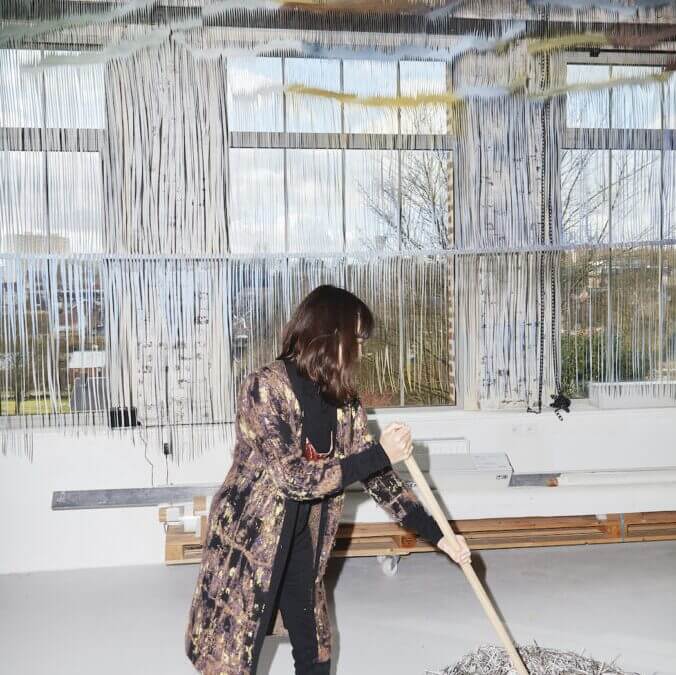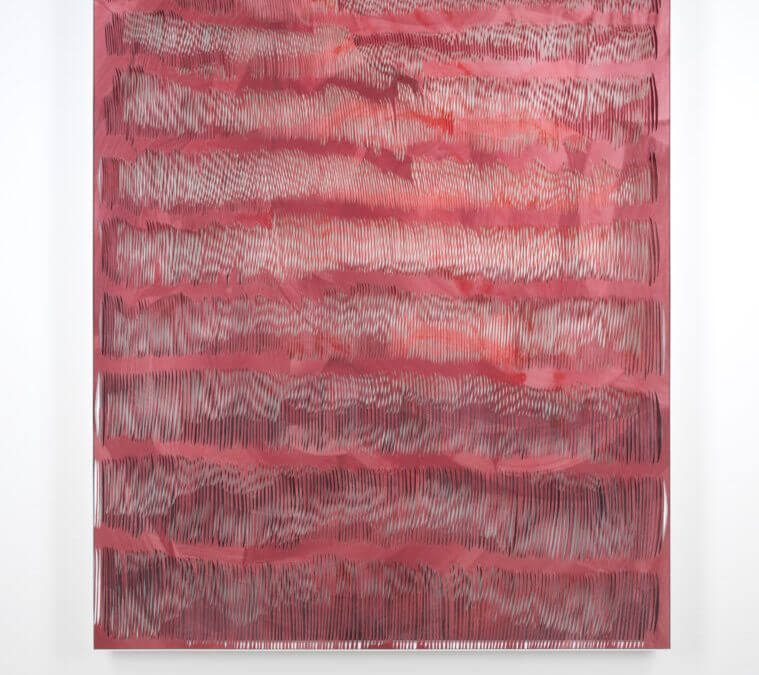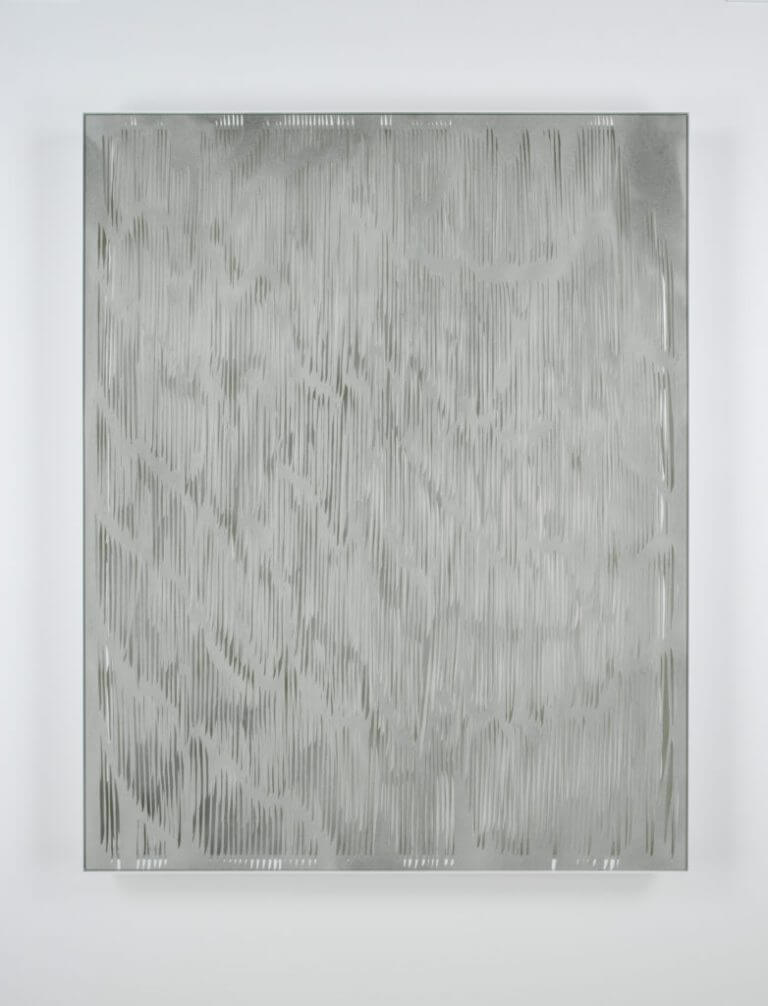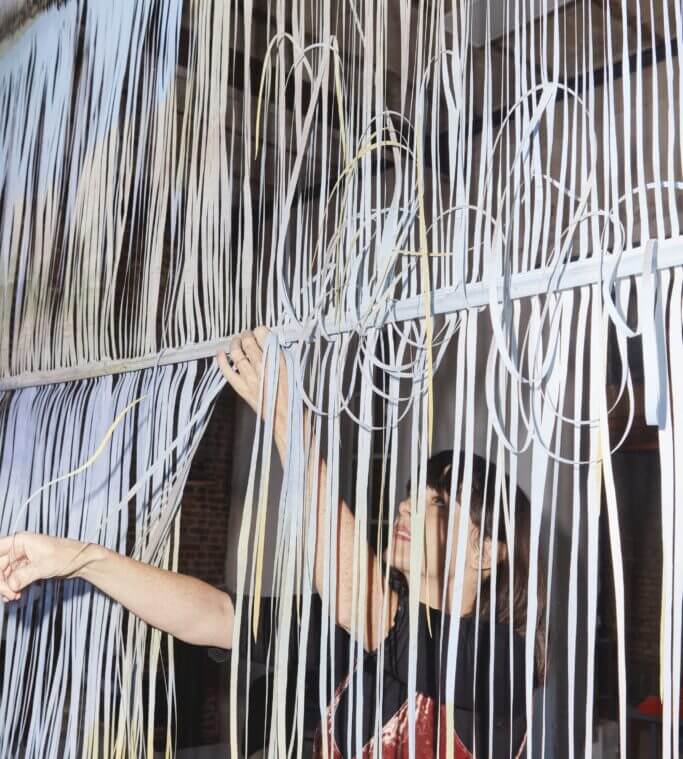CLEAR CUT: GEORGIA RUSSELL

There’s a certain satisfaction in discovering an artist by mistake, in a gallery you were never meant to be at, in the first place. Stumbling through a miserable heat wave in Cologne, killing time before my departure, I decided to test my luck and walk in – unannounced – to one of the oldest, most venerated contemporary galleries in the world: Galerie Karsten Greve, founded in 1972.
Once inside, I found a room with a series of intricately-cut and coloured canvases…by an artist named Georgia Russell. And from there, the band played on.
Russell was born in Elgin, Scotland in 1974 and studied fine art at the University of Aberdeen. She received her Masters in Printmaking from the Royal College of Art, London. She began her work with books while on an artist residency in Paris. Her works are held in the collections of The Victoria & Albert Museum (London), The Foundation Maison Particulière (Brussels) and the Centre Georges Pompidou (Paris). She has exhibited internationally at venues in New York, Paris, London, Hong Kong, and Edinburgh. She is the 2000 recipient of the Aurora Prize for Fine Art from the RCA (London).
Russell is represented by Galerie Karsten Greve (Paris/St. Moritz/Cologne) and lives and works in Méru, France with her husband, artist Raùl Illarramendi. In a FRONTRUNNER exclusive from our Spring 2020 Issue, Russell cuts to the quick.

From the Visitor series (2019)
Photography by Vincent Ferrane
What kinds of media did you begin with? The first types I saw at the gallery were mounted to the wall and books…
What you’ve seen in the catalogues and at the gallery, up until now, has been books…I’ve dissected books, also paper work and plexi. But now, gradually, over the last year or two I’ve been moving towards cut canvas. I’ve always wanted to make paintings, not traditional paintings, because they’re cut and made out of layers, and stretched out on completely new frames. Getting out of the plexi, getting into the canvases, painting them with big, gestural marks so that when I come on top with my cut, I’m interrupting all these old gestures with a new gesture. I wanted to create all these different directions interrupted by another thing. Not only layers, but it’s kind of abstract expressionist still, hopefully about all these contradictions in gesture.
Does it frustrate you, sometimes, that people compare your work to Lucio Fontana?
They have, they’ve done it in an interesting way, like it’s Fontana, but definitely not like Fontana [laughs]. I’m cutting canvas, there’s the idea of piercing something that’s immaculate, making it not immaculate anymore. But when you see them in real life…I guess, I don’t really mind it. In the catalogue that’s coming out, [one of the writers] mentions Fontana, but it’s really nothing like it.
You said interruption, which is a word I love. That’s more what I think of. I’m thinking about Fontana in a way that opens the abyss behind the space.
Exactly, yeah.
But when I look at you, it’s like space somersaulting over itself, inverting itself.
Thank you so much, that’s really perceptive. It’s how much space, how much space the void takes up, as well. The whole of the globe is being taken up, spaces overcoming and territories being filled up. And when you see my cuttings, maybe not the first thing you think of, but its like taking up space or invading a territory that was already there. There’s hardly anything left by the actual canvas, sometimes. It’s just hanging together by tiny bits of canvas.

From the Visitor series (2019)
Photography by Vincent Ferrane
The tensile type of quality to it. The most immediate association for me, though, was Mona Hatoum. Her works deal with the invasion of territory; this precision in the way territory is violated. It’s that point of no return. You make these calculated decisions about what to leave rather than what to invade. When you’re in the process of making these cuts, do you get claustrophobic by the mathematical element of it?
It’s not mathematical at all. It’s funny because recently I went to see Bernard Frize at the Pompidou. I was beginning to doubt if I liked his work. I went to see it, and was really impressed by his way of painting. He has systems and he follows them. You don’t know how he’s done it, the colours are really seductive. But by the end of it, what is it that’s making me feel tired, sick, vomiting? Like, “I’m going to divide this by three, then by five…” I’m not like that, actually. It’s a repetition I’m interested in, but an organic repetition. Half of its planned, and half of it is very organic. I know when I start what kind of fit I want, but it’s got to stay emotional, it’s got to stay gestural and expressive. There’s a technique, but no mathematical process.
Maybe it’s the word precision that, for me, lives side by side with mathematical. It’s hard for me to imagine something that precise being emotional. Maybe its a bit of Fibonacci happening? A bit of precision and chaos?
Maybe, yeah! Somewhere caught between Minimalism and plans. I don’t like a Pollock or a Frankenthaler. Caught up in all that, but its part of a long pathway that one action will lead to another action.
Is it fair to say that you want your hand to be shown?
Yeah, yeah. Something like laser-cutting would be a really ugly effect. I love the little faults, I love the tremors, it’s all living. Surface and layering and etching, breaking up spaces, was a good way of creating something. Staying on the same surface, for me, was never enough. By reducing, you’re creating so much more. Like opening a can of worms. What’s it going to be saying about space and the hand? Time and time passing, and what we do with it. It’s all nothing, anyway.
In the early part of your practice, where, as a young artist, there were moments where you might have lost that dialogue? Many young artists don’t immediately have that clear idea of their own practice.
You’re always chasing something, I’m never really fixed in my ideas, either. You have big moments of doubt, but it’s in those moments that something new might come out of it. It’s really encouraging when you think, “I can’t keep doing this anymore, I have to do something else.” It has to be stronger, better. These moments of doubt are essential, but you have to be confident enough to bring down what you made before and make something new. You have to break it apart, start something else.

Bed (2019)
Acrylic and gouache on canvas
250 x 200 x 12.5 cm
Courtesy of the artist
Did you have a singular breakthrough moment?
Yeah, that would have been in 2000. Probably with the first book piece. I was using old books. I was at the Royal College in London, I was in Paris for my residency, I was only 23 or 24. Hadn’t really got an identity of my work at all by then, I was making etchings and films. Then I found all these books, all different writers. In France, you know you’re in the city of romance, you think you should be buying all these books and reading them –
And a city of revolution!
Yeah, totally! I just loved them, and they were beautiful. All these brains that were outside just beside the river. Just so poetic. I bought them and started making collages and using them as sketchbooks, just sketching in cafés. I didn’t really know what else to do to get me started whilst I was there. These books suddenly became more interesting if I’d left them intact instead of pulling them apart doing collage. I started page by page, making them bigger, they looked like heads. Eventually I got the cut book thing, which you saw. I haven’t been doing so much of that recently, but will be going back. Just now, this is enough with the canvases. That would have been the biggest breakthrough for me because suddenly I was thinking you’re destroying something, but you’re not: is it political? Is it emotional? Is it psychological? It’s about text, it’s about writing, it’s about the brain. There’s so many things that it could be about that just interested me. That was a big, key time for me to start the cutting. Proper cutting, and how I would cut.
Not many artists would have the unbelievable opportunity to not only meet, but collaborate with a gallerist like Karsten Greve. Can you talk about how you met?
Yeah, that was a complete fluke. I was teaching part-time and selling through two smaller galleries: one in London and one in Marseille. I was living in France by this time, this was [already] after living in France quite a while. I thought, I’d better start paying my taxes in France, moving myself from Britain, cause I hadn’t done it yet. I was always moving back and forward.
So I was looking for an accountant, I asked friends around me if they knew an accountant and somebody by chance knew one, who was Bustamante’s accountant. I thought, “He’s not going to work for me. I’m this tiny little…” They said, “No, no, no, he’s very cool, he’s very young. He’s nice.” The accountant came to meet me and said, “Oh, I really like your work. I’ll be your accountant, it’s only going to take me half an hour!” [Laughs] He said, “Give me some of your images, I’ll show them to some of the galleries I work with.” We became friends, and not long after – six months later – I got a call from Judith Greve. I was like, “Is this a fake call?” She was like, “Our accountant showed me some of your images. It was a while ago now, but I just haven’t had the time to get back to you. Can I come and visit your studio?” So it was Judith who came to my tiny little studio in Paris, and invited me to show in a group show at the gallery, Works on Paper. I was like, “[Gasps], Oh my God!” I was showing beside Louise Bourgeois, I was like, “Oh, I have to step up my game, here!” Luckily I had been working pretty hard and I had been doing part-time work to pay the rent, but I’d never let it go. I always kept working. I was ready when that opportunity came around.
And thanks to the smaller galleries that had kept me going, too, because it was kind of fantastic that I was ready. After that, I was invited to show at FIAC, Judith left the gallery and luckily decided to keep going with us. It’s been, like, seven – eight – nine years, or something? When I met him, I couldn’t even talk! Like, “Are you sure about this?” He’s a character. He doesn’t speak a lot. Who I did meet recently who really impressed me was [Nicholas] Fox Weber (Director of the Josef and Anni Albers Foundation).

The Rains (2019)
Acrylic and gouache on canvas
150 x 120 x 12.5 cm
Courtesy of the artist
Let’s go back to the physicality of your work. What’s the next direction for you?
I’m so into these canvases, so I’m going to be making more of these. The next step is making big paintings, more layers, more structural. Continuing with these ideas, they move around a bit. A bit minimal.
You showed me one work that registers a kind of red, like it’s muscle tissue! It’s awesome.
That’s true! Two layers, one layer and a layer behind. They’re set off the wall, so there is a kind of floating feeling about them. They’re going to be cut, half-cut, with things protruding out of them, out of the folds. So far, it’s just really surfaces. Maybe more sculpture, more immersive, more installation-things, as well. Layers you can walk through in the gallery.
Do you feel like the work could approach kinesis?
Yeah, it does, in a way. It’s interesting. Nicholas Fox Weber is writing a text for the catalogue which is fantastic. He was overly enthusiastic, which I was taken aback by! He said the first thing was to compare it to a kind of kinetic – this vibration in between the two layers. But it’s not mathematical, not like Soto or Cruz-Diez. It happens almost by chance. It’s never going to be a constant. You’ve got to search out and find the kinetic bits. If you change your place in the room, it changes, itself.
The work has a dynamic to it where the viewer and the work, itself, meet in the middle in a fuller way.
It’s like something being alive in the room, like a fireplace. I remember saying to [my husband] Raùl [Illaramendi] when we moved in here that we can’t have a burning-log fire, which I was devastated about. I’ve got a country home and can’t have a fucking log fire! [Laughs] So I said I want a piano in the room, because I want something living. I need a candle-holder, or a fire, or a painting, or a piano, or something. There’s a shadow of something that was there in the morning but isn’t there in the afternoon. Neither of us play! But I love something about sitting down at a piano, I think it’s amazing. I’m so in awe. I found it really hard when I started learning, then I stopped. I think I’ve always had that regret.
Speaking of that, are there any ambient sounds or beings in your studio space in order for you to produce?
If I’m painting a big canvas on the floor, I can’t listen to the radio. Sometimes when I’m cutting, I can listen to interviews, because I know I’m going to be going up like that. I’ll stop and start, but I can kind of listen to the radio when I’m cutting. When I’m painting, I have to have music on to kind of get into my zone. I need to forget the world outside. With cutting, I don’t like anyone really being around. Sometimes, though, I don’t have a choice because I’ve got an assistant coming during the day to help me out. Ideally, if I could do everything on my own, I’d love to be able to, but because of the physical sizes and I need to get on with my ideas, I get help to speed it up a bit. But I also love interviews and podcasts, like [on] the Louisiana Channel (Louisiana Museum of Modern Art, Denmark).
Sounds boring, but I still love Pod Save America. That’s the only thing I can listen to nowadays without tasting bile in my mouth. I do get curious about artists’ political opinions and whether it filters into their work. Your husband’s work does walk into political dialogue, but I feel like yours doesn’t in any way.
I can and I can’t, there are underlying things going on. I was talking about territory, because it’s on my mind and it’s on everyone’s mind. I’m politically aware, but not at all an expert. I kind of fight with that because I feel like I should be more engaged; should I be doing more? Should I be making a point? I think it would be false for me to start doing work about something. I’ve been privileged, a privileged upbringing, white, European. I’m here, hopefully, to create a distraction and feelings and wellbeing for people who have suffered. I think there’s still space for that.nnBut I’m thinking about territory, thinking about climate change. Thinking about rain and floods and natural things in my work, as well. Some of them are evoking dark sand, no earth and sand anymore. So it’s there, but I’m not obviously doing amazing political pieces. Sometimes – and maybe this sounds completely selfish and horrible of me – but I think, “Can this just not be about anything for a while? Can we not forget all of this horrible stuff?
I think even just speaking about it amongst ourselves makes it worthwhile.
Yeah. And there are people who do it, and do it extremely well. I just don’t think that’s my place right now. For Raùl, it was burning up in him. He needed to do it. He’s been away from the country [Venezuela], and feels terrible about it. But I have to be genuine about the work, about the art. Hopefully it will reflect my time; breaking through layers, there’s half-seen things in it. Sometimes I think about how much shit you have to go through to get to the truth. All these layers, and confusions, and interruptions in my work.
If you were talking to an artist ten or fifteen years younger than you, which artists would you like them to discover?
I like Rashid Johnson. The work is so direct and so fast. At the beginning, I wasn’t drawn to it, but the more I look and the more I hear him discuss and talk, he’s so literate and so good at talking to people. He’s very engaging for young artists, too. Etel Adnan, I heard her speak a few years ago. Really inspiring.
I’m also curious about your broad opinion on the visibility of women in the arts, since you’re our first female cover artist for the magazine.
I tend to lean towards that everyone should be seen as an artist. I think France has been lucky in the fact that Louise Bourgeois was discovered and she’s done a whole lot for women, and making people aware of women artists. Tatiana Trouvé, as well. These names come to mind in an equal, French way. British, as well. I think there could be more racial equality in the arts rather than male-female. But I’m not really in the “in crowd”, I’m not really one to know who the director of this museum is, or what time, so you probably know more about that than I do. But something else that might interest you, is that I’ve been selected to show at the National Museum of Women in the Arts in Washington, DC next summer.
Brava!
But I also have to mention Phyllida Barlow, as well. I think her approach is so healthy. I don’t know if I like all of the work, when you see it in fairs it doesn’t seem to work for me, but that’s fairs [laughs].
But regarding the fairs and mega-galleries, do you think these young artists and spaces have a shot now?
I wonder. I hope so. I think the art world is so big that they’re going to want new food. The machine has to be fed, so they’re going to go out there searching for them. But it’s the kind of mid-sized galleries that are all getting pushed out.
How do you feel about young artists being anxious about having to be their own social media manager, their own publicist, having to be everything? Could it be too much?
It can be for some people. Some people are just fantastic at it, these big powerhouses and they seem to be able to do it all. I’m certainly not like that. I’m full up to here already with what I want to do and create and produce in the work, and I don’t want that to be part of it. But it could be part of the whole artwork, as well. It’s a big choice for everyone to make, they have to look at it sensibly and say, “Is this good for me, or not?”

From the Visitor series (2019)
Photography by Vincent Ferrane
If you could pinpoint it, what is the best piece of advice you’ve ever received as an artist?
Someone told me once, “Never doubt.” Because that’s all we do. But it gave me that tilt as to say, you know, “Fuck it.” If I make this and it doesn’t work, fuck it, it doesn’t matter. Let go of your control that you want over the work. Let yourself do the mediocre stuff for awhile to get up higher. Just never doubt.
As a fun question, do your kids ever help you develop new things in your work?
Yeah! Definitely. For some, it may be a handicap and I’m sure it has been both. But my second child, who I just had two years ago – that was too late to have a child, stupid idea! [Laughs] – he made me stop because I had a mild depression, and anxiety attacks, just from being a mum. He made me stop for a year, and then I was even more fervent to get back. I couldn’t wait to get back. I was so lucky. My daughter sometimes says, “Mummy, don’t cut that up. Leave it.” You know they say animals and children always tell the truth. I listen to them.
Georgia Russell appears on the cover of the FRONTRUNNER Spring 2020 Issue. Order it here.